Increase Hip and Trunk Stability with Loaded Carries for Injury Prevention, Rehabilitation, and Performance
by Jason Taylor, CSCS and Mason Reed, CSCS
NSCA Coach
December 2020
Vol 7, Issue 3
The goal of this article is to understand contralateral and ipsilateral loading, how to set-up loaded carries, electromyography activity during exercises, and how to apply these exercises into the strength training program.
Introduction
Core strength is a popular topic in the fields of strength and conditioning and rehabilitation as it can aid in both athletic performance and injury prevention. The term “core strength” or “core stability” has many definitions in the literature, including the ability to maintain proper trunk position over the pelvis to efficiently produce, control, and transfer force during any athletic activity (14). The definition of “core” includes all muscles that attach or insert between the shoulder girdle and pelvis because they all impact the axial system and control of trunk and torso muscle activity (18).
“The definition of “core” includes all muscles that attach or insert between the shoulder girdle and pelvis because they all impact the axial system and control of trunk and torso muscle activity (18).”
Tweet this quote
Core strength can effectively be developed through exercises that are mat-based, ball-based, and whole-body (14). One of the most effective ways to develop core strength is through loaded carries, a whole-body exercise. Loaded carries are movements that consist of “loading” oneself with a weighted implement and walking for a predetermined distance or time. As an effective, yet simple exercise variation, loaded carries can develop and enhance muscle strength, as well as training proper movement patterns (1).
There are several variations of loaded carries that are used to target different parts of the body. These variations of exercises challenge the body’s stabilizing system to possibly find weak links in the body that can lead to either suboptimal athletic performance or injury (10). There are two variations that will be the focus of this article: the traditional (bilateral) farmer’s walk (Figure 1) and the unilateral famer’s walk (Figure 2). Winwood et al. suggest that the farmer’s walk exercise is a valuable training implement that requires the use of unstable and awkward resistances that stabilize uniplanar and multiplanar motions (17). Programming this exercise may have the potential to increase anaerobic endurance, back endurance, and grip strength. Other variations of loaded carries include the yoke walk (weight across the upper back), rack carries (Figure 3), Zercher carries (Figure 4), and unilateral overhead carries (Figure 5) (10). Dumbbells are a common implement to use as the load; however, kettlebells, barbells, and weight plates can be used as well.
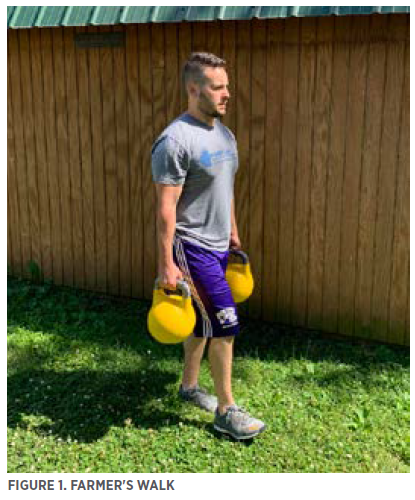
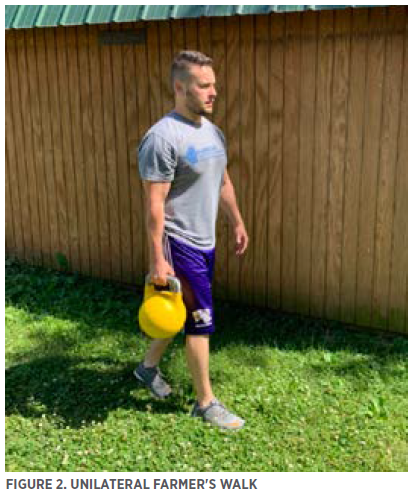
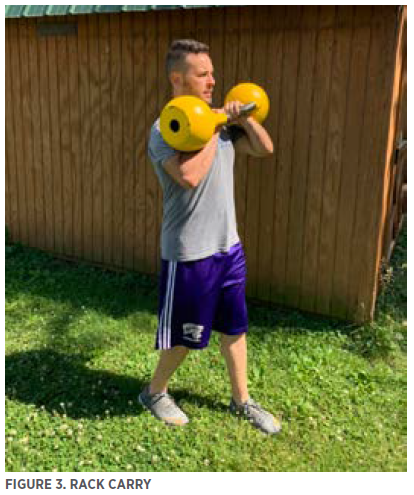
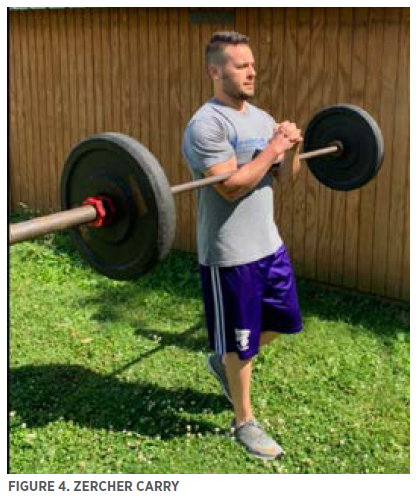
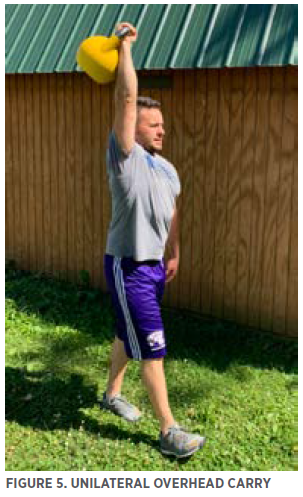
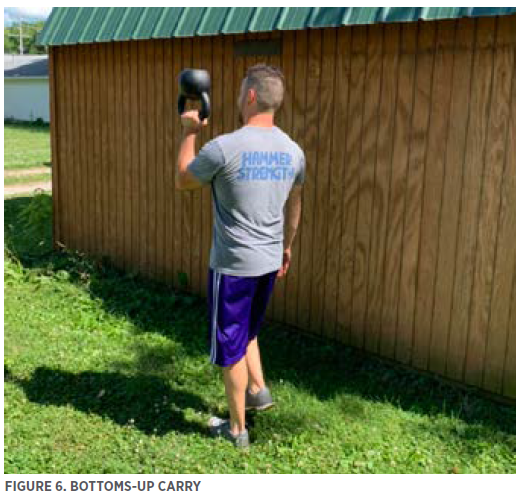
These variations of exercises require the body to maintain posture through coordination of trunk and hip musculature activation (6). It is important for strength and conditioning professionals to understand why and how to properly implement loaded carry exercises for the safety and development of the athlete. There is currently little research on loaded carries in the fields of strength and conditioning and rehabilitation. Therefore, the goal of this article is to understand contralateral and ipsilateral loading, how to set-up exercises, EMG activity during exercises, and how to apply these exercises into the strength training program. Better understanding of these areas will help coaches better select exercises based on the needs of their athletes and corresponding sport demands.
Contralateral and Ipsilateral Loading
One reason that exercise selection is particularly important with loaded carries is because it impacts the position of the load. One muscle that is heavily impacted by the carrying position is the gluteus medius. When carrying the dumbbell on the contralateral side there appears to be greater gluteus medius and vastus lateralis muscle activity compared to very minimal activation when carried on the ipsilateral side (10). However, there is the possibility of cross education; the contralateral strength gain following unilateral training of the ipsilateral limb (4). It is currently believed that neural mechanisms are responsible for the cross education of contralateral musculature as there is no hypertrophy in the untrained side (2). A recent large review of unilateral training studies reported cross education strength gains of 18% in young adults, and 29% in a rehabilitation setting (4). Therefore, cross education is of clinical importance for rehabilitation and strength and conditioning professionals.
Exercise Set-Up
There are many ways to implement the loaded carry. A general rule of thumb for these exercises is to maintain an upright torso, walk slow and controlled, and to avoid any lateral bending of the spine for unilateral exercises. All exercises that are described can be programmed as either timed exercises or over a set distance. A good starting point for someone who is deconditioned or coming back from an injury would be the farmer’s walk carrying equal weight in each hand. From there, the practitioner can decide to implement unilateral farmer’s walks, otherwise known as suitcase caries, where weight is carried on one side. Suitcase carries can progress into advanced, loaded carry variations.
The waiter’s walk challenges stabilizing muscles in the shoulder and is performed by carrying weight overhead in one hand. Rack carries are performed by placing two kettlebells or dumbbells on the anterior portion of the shoulder and upper chest. The bottoms up walk (Figure 6) is preferably performed with a kettlebell and challenges stabilizer muscles of the wrist and shoulder by holding the kettlebell upside down by the “horn” with the shoulder flexed at 90 degrees and the wrist staying neutral. Loaded carries can be placed into the beginning of a workout to potentiate the neuromuscular system or at the end of a workout session as a form of conditioning (1).
EMG Research
The use of loaded carries became popular through the sport of strongman. Strongman events represent functional movements in multiple planes that challenge the entire body. As a result of increasing popularity in strongman events, strength and conditioning professionals are now using these movements in their programming. McGill et al. compared muscle activation of different strongman events showing the importance of the lateral spine muscles, such as the quadratus lumborum and the lateral abdominal wall, during the suitcase carry as they have been found to stiffen the pelvis to prevent it from bending toward the side of the leg swing (9,10). Pelvic stiffening helps the hip abductors create a stable platform for the spine. During the farmer’s walk, peak muscular activation of the abdominals and rectus femoris occurred during the stance phase, and peak activation of the latissimus dorsi, thoracic and lumbar erector spinae happened during the swing phase (10).
Walking, with or without loads, is a fundamental occupational activity and needs to be investigated at submaximal loads. It is also useful to compare the differences in carrying weight in one hand versus two. McGill et al. found that carrying a load in one hand generates a greater spine load than if the load were split between two hands (8). When carrying the load in only one hand, compared to having a balanced load in each hand, there was a greater spinal load even though twice as much weight was carried when both hands were loaded. It is also valuable to examine muscles of the lower body when performing the farmer’s walk. Previous research has reported that individuals with a hip abduction to hamstring strength ratio (HAB:H) of less than one have greater activation of gluteus medius activity during exercises such as the farmer’s walk. This could be of importance when programming for injured or previously injured athletes (16).
Other loaded carry styles that have been examined are the “racked” and “bottoms up” carry. McGill et al. reported that torso and hip activation were very low for both styles of carries, with 0.1% maximum voluntary contraction (MVC) for the racked group and 14.3% MVC for the bottoms up group (8). These trials were compared to normal walking. However, low activation for the hips does not mean that these exercises are useless, but it does mean that they would not aid in developing hip or trunk stability.
Practical Application
Core muscle training and health are highly important in strength and conditioning and rehabilitation settings. Core strength helps maintain proper core stabilization and force transmission. During dynamic, loaded movements in sports, athletes are required to maintain stability while also performing the necessary skill. As previously mentioned, core stability has many definitions, but can be defined as the ability to maintain proper trunk position over the pelvis to efficiently produce, control and transfer force during any athletic activity (14). These sporting activities require force transmission from the ground to be transferred to the core muscles to the distal segments. If the core muscles are strong, then force transmission is efficient and little energy is wasted (14). It is very common for athletes with weak hip musculature, especially the gluteus medius, to later develop associated knee pathologies (12). Unsurprisingly, weakness at the hip can also contribute to upper body injuries such as shoulder labral tears (7). This associated injury risk shows the importance to consider loaded carries as a training tool to reduce injury risk and ensure proper force transmission.
When programming loaded carries for sports, we can evaluate the role of core strength when it comes to running and cutting. Running and cutting are quick movements, and any spine bending that results with a drop in the pelvis on the swing leg side can be described as an energy leak leading to an inefficient system that requires the athlete to use additional energy stores to produce the same amount of movement (8). One particular problematic area to look for is the presence of valgus collapse at the knee. This is a known risk factor for ACL tears, as well as generalized knee pain. Because non-contact ACL tears are common in female athletes, with Q angle (i.e., the relationship between the anterior superior iliac spine and intercondylar ridge) being reported as a contributing factor, loaded carries may be one way to help strengthen the gluteus medius to prevent excessive valgus collapse (7,13).
When considering the shoulder, these exercises could also benefit athletes who spend a lot of time overhead such as basketball players, throwing athletes, and wide receivers. Many of the thoracic muscles are activated during loaded carries and can help maintain proper scapulothoracic function. In addition to maintaining proper subacromial space, these exercises would add an additional stability aspect when the athletes are reaching overhead. Maintaining proper subacromial space and glenohumeral stability is important for athletes that spend a lot of time in an overhead position (i.e., throwing athletes, swimmers, and lacrosse players). Glenohumeral stability is especially important for wide receivers who need to jump with their arms extended and are often hit in this position.
These exercises can also be applied in rehabilitation settings. As previously mentioned, a cross education effect appears to occur with the contralateral side. Although most of the movements require ambulation, it is possible to have them just hold a designated position to strengthen the muscles, along the lines of Trendelenburg’s test. Trendelenburg’s test is designed to determine if there is a weakness in the gluteus medius. It is accomplished by have the individual flex one hip to 30° and looking for a drop in the unsupported limb (5). These exercises can also be used with individuals who have undergone ACL repairs. Depending on if any meniscal damage was repaired, these individuals are usually allowed to weight bear and walk fairly early in their recovery process. Once a normal gait pattern is restored, these exercises could be added to develop hip strength in a weight bearing position without adding stress to the knee.
Because there is currently limited research available on loaded carries, there are few recommendations on number of sets, time under tension, and distance covered for safe programming. However, Holmstrup at al. were the first to present safe maximal loading parameters for the unilateral farmer’s walk (UFW) (6). The parameters used were fat free mass (FFM) and the Balance Error Score System (BESS) test. FFM includes all tissue in the body that is not composed of fat (i.e., lean muscle mass, organs, connective tissue, bones, and water). The BESS test involves counting “errors” or times of lost stability the individual encounters during a 30 second period. All tests are conducted with the eyes closed and the hands on the iliac crests. The three testing positions are 1) standing on both feet with them touching, 2) on the non-dominant foot only, and 3) feet in tandem with the non-dominant foot in the back (3). These standards are set at UFW = (0.819 x FFM) + (0.482 x BESS) – 9.411. While these parameters are not perfect, they give the training professional a practical, evidenced-based approach to determine load for the unilateral farmer’s walk.
Due to a lack of scientific evidence, anecdotal evidence from fitness professionals presents the next best evidence. Butcher et al. suggest 2 – 4 rounds for 10 – 20 s with a weight that is challenging (1). For measures of functional strength, these researchers have also provided metrics for performance across different populations including:
- Rehabilitation: 50% of bodyweight carried for 30 s
- General fitness: 100% of bodyweight carried for 30 s
- Elite sports performance: 200% of bodyweight carried for 30 s
These recommendations are based on the bilateral farmer’s walk, but can provide a foundation for many other exercises as well.
Conclusions
A review of the literature shows that the implementation of loaded carries can improve hip and torso muscle function, leading to improved systemic muscular function. Focusing on core strength via loaded carries for athletes can decrease the rate of injury, as well as be useful for rehabilitation. The information provided in this paper adds to the growing body of literature on loaded carries particularly due to strongman events. There is a need for additional future research to develop safe loading patterns and program recommendations for all variations of loaded carries and for specific populations.
This article originally appeared in NSCA Coach, a quarterly publication for NSCA Members that provides valuable takeaways for every level of strength and conditioning coach. You can find scientifically based articles specific to a wide variety of your athletes’ needs with Nutrition, Programming, and Youth columns. Read more articles from NSCA Coach »
Related Reading
References
1. Butcher, S, and Rusin, J. Core strength and functionality with loaded carries. NSCA Coach 4(3): 24-28, 2017.
2. Fimland, MS, Helgerud, J, Solstad, GM, Iversen, VM, Leivseth, G, and Hoff, J. Neural adaptations underlying cross-education after unilateral strength training. European Journal of Physiology 107: 723-730, 2009.
3. Finoff, JT, Peterson, VJ, Hollman, JH, and Smith, J. Intrarelater and interrater reliability of the balance error scoring system (BESS). American Academy of Physical Medicine and Rehabilitation 1: 50-54, 2009.
4. Green, LA, and Gabriel, DA. The effect of unilateral training on contralateral limb strength in young, older, and patient populations: A meta-analysis of cross education. Physical Therapy Reviews 23(4-5): 238-249, 2018.
5. Hardcstle, P, and Nade, S. The significance of the Trendelenburg test. The Journal of Bone and Joint Surgery 67 (B5): 741-746, 1985.
6. Holmstrup, ME, Kelley, MA, Calhoun, KR, and Kiess, CL. Fat-free mass and the balance error scoring system predict an appropriate maximal load in the unilateral farmer’s walk. Sports 6(4): 166, 2018.
7. Kibler, WB, Press, J, and Sciascia, A. The role of core stability in athletic function. Sports Medicine 36(3): 189-198, 2006.
8. McGill, SM, Marshall, L, and Andersen, J. Low back loads while walking and carrying: comparing the load carried in one hand or in both hands. Ergonomics 56(2): 293-302, 2013.
9. McGill, SM, and Marshall, LW. Kettlebell swing, snatch, and bottoms-up carry: back and hip muscle activation, motion, and low back loads. The Journal of Strength and Conditioning Research 26(1): 16-27, 2012.
10. McGill, SM, McDermott, A, and Fenwick, CM. Comparison of different strongman events: Trunk muscle activation and lumbar spine motion, load, and stiffness. The Journal of Strength and Conditioning Research 23(4): 1148-1161, 2009.
11. Neumann, DA, and Cook, TM. Effect of load and carrying position on the electromyographic activity of the gluteus medius muscle during walking. Physical Therapy 65(3): 305-311, 1985.
12. Rowe, JR, Shafer, L, Kelley, K, West, N, Dunning, T, Smith, R, and Mattson, DM. Hip strength and knee pain in females. North American Journal of Sports Physical Therapy 2(3): 164-169, 2007.
13. Smith, TO, Hunt, NJ, and Donell, ST. The reliability and validity of the Q-angle: A systemic review. Knee Surgery, Sports Traumatology, Arthroscopy 16: 1068-1079, 2008.
14. Srivastav, P, Nayak, N, Nair, S, Sherpa, LB, and Dsouza, D. Swiss Ball Versus Mat Exercises for Core Activation of Transverse Abdominis in Recreational Athletes. Journal of Clinical and Diagnostic Research 10(12): YC01-YC03, 2016.
15. Stastny, P, Lehnert, M, Zaatar, AM, Svoboda, Z, and Xaverova, Z. Does the dumbbell- carrying position change the muscle activity in split squats and walking lunges? Journal of Strength and Conditioning Research 29(11): 3177, 2015.
16. Stastny, P, Lehnert, M, Zaatar, A, Svoboda, Z, Xaverova, Z, and Pietraszewski, P. The gluteus medius vs. thigh muscles strength ratio and their relation to electromyography amplitude during a farmer’s walk exercise. Journal of Human Kinetics 45(1): 157-165, 2015.
17. Winwood, PW, Cronin, JB, Posthumus, LR, Finlayson, SJ, Gill, ND, and Keogh, JW. Strongman vs. traditional resistance training effects on muscular function and performance. The Journal of Strength and Conditioning Research 29(2): 429-439, 2015.
18. Wirth, K, Hartmann, H, Mickel, C, Szilvas, E, Keiner, M, and Sander, A. Core stability in athletes: A critical analysis of current guidelines. Sports Medicine 47(3): 401-414, 2017.
- Privacy Policy
- Your Privacy Choices
- Terms of Use
- Retraction and Correction Policy
- © 2025 National Strength and Conditioning Association